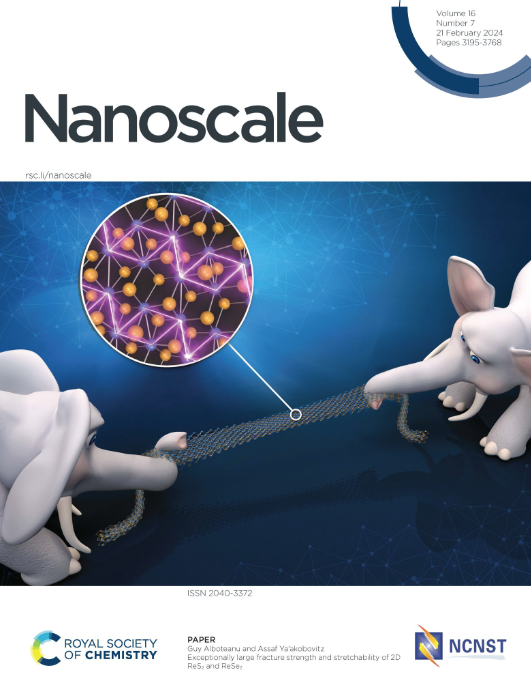2 eV band gap tuning and optical properties of AgIn5S8 Quantum Dots
IF 5.8
3区 材料科学
Q1 CHEMISTRY, MULTIDISCIPLINARY
引用次数: 0
Abstract
In this work, we demonstrate the colloidal bottom-up synthesis of spinel AgIn₅S₈ quantum dots (QDs) with tunable optical properties. The QD size, and consequently their band gap energy (Eg), is effectively controlled by reaction temperature and ultrasound (US) irradiation. Under combined conditions of 75 °C and US irradiation, ultrasmall QDs with an average size of 2.6 nm are obtained, exhibiting a wide band gap of 3.77 eV. In the absence of US, reactions conducted at 55 °C and 75 °C yield larger QDs (~5 nm and 31 nm, respectively), with reduced band gaps of ~3.1 eV and 2.2 eV. The elevated temperature (75 °C) suppresses sulfur-chain formation that otherwise limits growth at 55 °C, while acoustic cavitation induced by US enables narrowest size distribution. Annealing of as prepared QDs, at 200 °C for 2 h, promotes coalescence resulting in QDs with increased size of ~ 34 nm, with a bulk like band gap of 1.73 eV for QDs prepared without US. In contrast, annealing of the QDs, prepared with US, results in polycrystalline QDs with average size of ~ 21 nm. High-resolution transmission electron microscopy reveals a strong correlation between QD size, structural ordering and optical behavior. The as-prepared 2.6 nm QDs exhibit lower Urbach energy, attributed to their single-crystalline nature, unlike the less ordered QDs synthesized without US. Annealing improves structural ordering and reduces Urbach energy in QDs prepared at 75 °C, while stacking faults and grain boundaries in other QDs hinder such improvements. Photoluminescence measurements further confirm a strong relationship between QD structure, size, and emission characteristics. The synthesized AgIn₅S₈ QDs exhibit remarkable band gap tunability of up to 2 eV across the visible spectrum and sharp band-edge emission, underscoring their potential for applications in optoelectronic and biomedical devices. This work provides a robust and sustainable pathway to high-performance, non-toxic QDs, addressing a key bottleneck for their use in biocompatible and consumer electronics.AgIn5S8量子点的eV带隙调谐及光学特性
在这项工作中,我们展示了胶体自下而上合成尖晶石AgIn₅S₈量子点(QDs),具有可调谐的光学特性。反应温度和超声(US)辐照可以有效地控制量子点的大小和带隙能(Eg)。在75 °C和US辐照条件下,获得了平均尺寸为2.6 nm的超小量子点,带隙为3.77 eV。在没有US的情况下,在55 °C和75 °C下进行的反应产生了更大的量子点(分别为~5 nm和31 nm),带隙减小到~3.1 eV和2.2 eV。升高的温度(75 °C)抑制了硫链的形成,否则会限制55 °C的生长,而US引起的声空化使尺寸分布最窄。将制备的量子点在200℃下退火2 h,促进了量子点的聚结,导致量子点的尺寸增加到~ 34 nm,没有US的量子点的带隙为1.73 eV。相比之下,用US制备的量子点退火得到的多晶量子点平均尺寸为~ 21 nm。高分辨率透射电子显微镜显示量子点尺寸、结构有序和光学行为之间有很强的相关性。由于其单晶性质,制备的2.6 nm量子点表现出较低的厄巴赫能,这与不含US合成的较低有序的量子点不同。退火改善了75 ℃下制备的量子点的结构有序性,降低了厄巴赫能,而其他量子点的层错和晶界则阻碍了这种改善。光致发光测量进一步证实了量子点结构、尺寸和发射特性之间的密切关系。合成的AgIn₅S₈QDs在可见光谱上表现出高达2 eV的卓越带隙可调性和锐利的带边发射,强调了它们在光电和生物医学设备中的应用潜力。这项工作为高性能、无毒的量子点提供了一条稳健和可持续的途径,解决了它们在生物相容性和消费电子产品中使用的关键瓶颈。
本文章由计算机程序翻译,如有差异,请以英文原文为准。
求助全文
约1分钟内获得全文
求助全文
来源期刊

Nanoscale
CHEMISTRY, MULTIDISCIPLINARY-NANOSCIENCE & NANOTECHNOLOGY
CiteScore
12.10
自引率
3.00%
发文量
1628
审稿时长
1.6 months
期刊介绍:
Nanoscale is a high-impact international journal, publishing high-quality research across nanoscience and nanotechnology. Nanoscale publishes a full mix of research articles on experimental and theoretical work, including reviews, communications, and full papers.Highly interdisciplinary, this journal appeals to scientists, researchers and professionals interested in nanoscience and nanotechnology, quantum materials and quantum technology, including the areas of physics, chemistry, biology, medicine, materials, energy/environment, information technology, detection science, healthcare and drug discovery, and electronics.
 求助内容:
求助内容: 应助结果提醒方式:
应助结果提醒方式:


